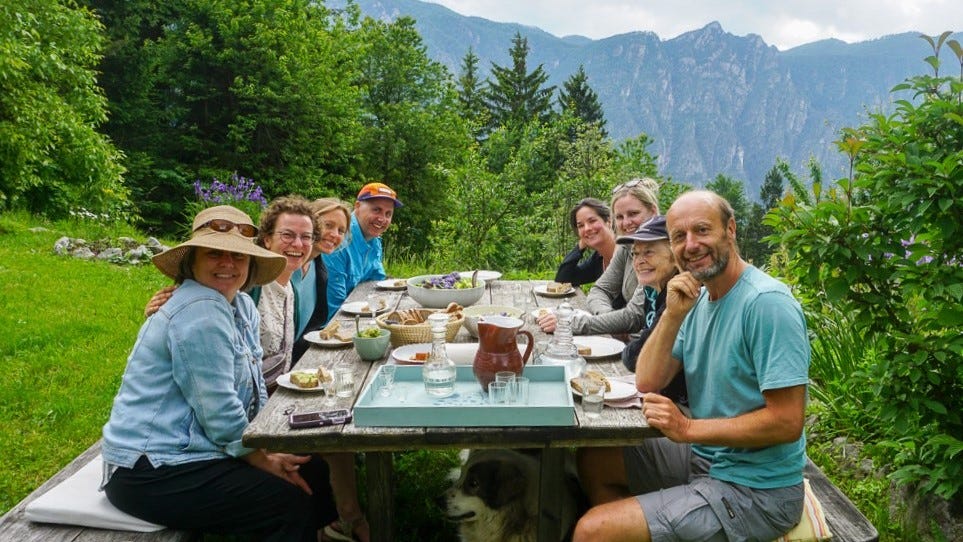This is an article co-created by
and on the topic of designing an open source knowledge commons for village builders. We had a virtual conversation and recorded it, and we’ve teased out the themes, tools, and agreements that we explored into this article.Fair warning, this article is niche AF and slightly technical. But if you’re curious about this idea, read on.
Jacob and Nicole being village building nerds
Key questions that came away from our conversation:
How can we create an ethical open source model for knowledge sharing?
What are the current enemies of open source knowledge sharing?
Do we have all the tools we need to organize information at the level of sophistication that we want?
The Need for a Knowledge Commons
All we want for Christmas is an open-source-knowledge-commons-for-village-building.
A knowledge commons for regenerative village builders? Yes please. A go-to place for information, best practices, and experiences related to creating sustainable communities.
This resource is crucial for several reasons:
1. Consolidating Scattered Information
Currently, information about building regenerative villages is dispersed across various sources, making it challenging for newcomers and even experienced builders to access comprehensive knowledge.
There's a wealth of information out there, but it's not always easy to find or navigate.
2. Facilitating Learning and Skill-Sharing
A knowledge commons would allow village builders to learn from each other's experiences, avoiding common pitfalls and replicating successful strategies.
We need a platform where a variety of specialized knowledge can be shared.
3. Supporting Different Stages of Village Development
From initial planning to ongoing maintenance, a comprehensive knowledge commons would support builders at every stage of the process.
Why the Field Suffers Without It
Reinventing the Damn Wheel — Without a centralized knowledge base, many village builders are forced to waste time and resources on problems that others have already solved.
Lack of Cohesion — the absence of a commons is the absence of mycelium in a forest, with communities developing in isolation without benefiting from shared knowledge.
Barrier to Entry — the scattered nature of information creates a significant blockade for those interested in starting regenerative villages.
Slower Progress — regenerative village building moves in slo-mo without a shared knowledge base, as lessons learned in one project are not easily accessible to others.
Difficulty in Scaling — scaling up the concept of regenerative villages becomes more challenging without a centralized resource for knowledge and best practices.
In essence, a knowledge commons would be a big win for aspiring village builders and existing communities alike.
With the right tools and community engagement, such a knowledge commons could become a pile of gold for regenerative villages worldwide.
Key Design Challenges
But we can’t just pile folders together in a shared drive and call it good. The knowledge base must achieve:
Information organization
Open source but centralized
Maintaining information quality
User-friendly navigation
1. Information Organization
One of the primary challenges we discussed is how to effectively organize the vast amount of information related to village building.
We’d have to accommodate for different information taxonomies.
Info could be organized by bioregion, or perceived stage of village development, but also perhaps split into categories like food, water, waste, energy, social dynamics.
Jacob suggests it would be useful to "lead people through this information" with a high level of intention and design of the information, vs. a free-for-all wiki dump.
The decisions on how to approach this are inconclusive.
2. Balancing Centralization and Decentralization
On one hand, you can’t possibly hope to create all knowledge on the topic. It takes resources to write the books, code the software, or build the toolkit under a single brand or organization.
We don’t have the drive to do that. At this stage, we’re just nerdy about building a cabinet of village building resources.
Obviously, each organization will have its own unique approach, and there is value in simply cataloguing. A parseable, linkable format — usable by multiple applications — would be fantastic.
But decentralization comes with its own issues.
Jacob: "Part of me doesn't want to store all of it, but keeping it decentralized [could be problematic]. When I think about building the open eco builder to guide someone through this land-based project and physical infrastructure 3D modeling, a lot of the content you end up using is actually hosted somewhere else."
Links to other sites break, information goes out of date, and a completely decentralized system can lead to low quality of resources. Which leads us to—
3. Maintaining Information Quality
Nicole: "This is where it starts to get tedious, in the amount of curation that has to go into keeping an open information space organized."
Jacob: “So each repository can have its own set of rules around who can propose changes.
Then you can set experts on different sections and say, hey, here's our food forest expert. So if anybody wants to change the design rules for a food forest in this bioregion, then it's going to run through this person.
So, you can have experts and you can still have a core team of people who maintain this knowledge base, while still being able to share it freely and have people from the outside make contributions to it, but [with] the scale of information I feel like it's going to require a larger community to be contributing.”
To maintain the information quality, it’s easiest and more precise to have an automation to periodically check links and even flag for review when the content changes.
To curate the information, it’s best to have a core team. This gets tricky when we want to keep it open source and still have people motivated to “work” on it long-term.
Remember, OpenAI thought it could stay open source, but they miscalculated how much it would cost to keep themselves running.
OpenCollective gives us an example of having transparent funding and bounties for open source projects.
4. User-friendly navigation
Do we dig rabbit holes or do we build meerkat tunnels?
Rabbit holes are linear and go straight down. Meerkat tunnels are dense, overlapping, and characterized by levels with different caches of value. They match the level of complexity of the information we need, but you might get lost.
UX/UI is king when it comes to making sure users continue to engage with the platform.
We know we need an intuitive information search and retrieval, a non-ugly interface, and enough features to get the job done.
Adequate technology and tools for building this knowledge base
List of Tools (comment more if you know more!)
Open Eco Builder — Jacob’s project
GitHub/GitLab
Obsidian
Kumu or other mapping tools
Mumurations — physical map-centric
An avid Terrenity reader,
writes extensively on building public wikis, and his articles are also has tools he recommends in his article about what a knowledge commons is, which you can read here.In some sense, we wish we could build something like
, but open source.Ethical Open Sourcing
Nicole: “I have my own personal library, for example, of PDFs and books you can buy from the author that I share to my circle. The same way you might lend a book from your bookshelf in the past. And when someone buys a course, for example, they tell me ‘I'll give you my login’ because we're friends.
I may be sharing something that technically should have a paywall in order to credit an author or its creator. But I paid for it or obtained it, somehow, through some effort, and now through open source principles I'm sharing it with a very wide, wide, wide circle of ‘friends’.
So there's issues of like, okay, do we support the work of people who make it possible to do what we’re doing, or do we accelerate a more regenerative world and push to transition away from the current economy?”
It’s like anti-hoarding.
Nicole: “Like anyone, I can be ethically ambiguous at some times. One of my other village builder friends jokes about us being pirates, because we voraciously exchange information with each other.“
Current privatized models often hinder this. Even without these systems, the desire to compensate and attribute credit to the content creators may remain.
Proposed Solutions
1. Multi-faceted Information Presentation
So we should start dividing resources into main categories, and creating a hierarchy.
But!
Different brains access information differently. Some people glitch when they look at GitHub’s nested list of folders, while others look at mind maps and don’t know where to start.
Ideally, you will view information through visual collaborative mapping, and in a list directory, and in folders and subfolders, à la Github.
2. Gamification
Added elements of gamification can walk through the steps of village building, from the physical infrastructure to the governance and business modeling.
Village building is societal redesign anyways, why not learn how to prototype regenerative societies with software?
3. Affiliate linking or PPV
While we won’t charge to access content linked in the knowledge base, we can always redirect to where the content is available for sale, and get a kickback for sending people there. That way, creators are happy and the initiative is self-sustaining financially.
Jacob: Another option — if we had enough weight behind the platform — would be to do regular payouts based on the use of attributed information. Kind of like how streaming services pay artists. Each time someone accesses it, $0.01 -- each time they like it, $0.05. But then we're back to centralizing all the information…
Bonus Features
AI-Assisted Organization & Relationship Logic
Nicole: "The ideal tool reads the resources, analyzes the main concepts, and then draws the connections in between. If I could plug information into Obsidian and not have to manually tag it, but let the tool draw conclusions in between a library of concepts, then there's a brain! It's my village building brain.”
What’s Next?
Building an open source knowledge commons for regenerative villages presents both challenges and exciting opportunities.
We want it because we want to accelerate the development of sustainable communities worldwide.
Jacob: We might just have to start building it and see how it fleshes out.
One of my affiliated partners, Community Finders, run by Cynthia Tina, offers services for people seeking ecovillages or building ecovillages. I highly recommend you join one of her courses to uplevel your ecovillage journey.
Use the code TERRENITY for $100 off your ecovillage tour.












I am delighted to be on this journey with you! Thanks for the discussion and synthesis of our ideas. This month is busy with moving out to the Domestead, but I'm excited to dig into this more soon! 🙌💚
Hey friends,
Just dropping a note about hylo.com
We are "knowledge commons adjacent" as such. A place for discussion, coordination and linking to communal knowledge.
While the platform isn't going to go into a 'wiki' direction, we do want to be the melting pot for all the different strands of regenerative culture, and offer things like an in-built learning-management-system. Give it a gander and reach out if anything catches your eye :)